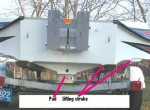Re: Bass Boat "Pad"??
Below is artical on one of the best hulls every made..Hydrostream. It describes the evolution of pads on boats.
"When discussing hull technology, we must consider many variables that formulate the performance potential of a particular hull, and how this performance should best be exploited. Some things to consider are propeller type and size, hull weight and size, setback, amount and weight of the power unit, the situations the hull will be used in, water conditions, and of course, the hull design itself. For purposes of this discussion, we shall focus on the V, XT, and YT bottom designs.
It all started with the padded V-bottom we are all familiar with. The V-bottom is basic in design, and very efficient from a physical standpoint. Hydrostream introduced several versions of this, but basically they belong to two categories � hooked and non-hooked. Generally, the padded V-bottom hull requires less horsepower to achieve satisfactory performance than its counterparts. Why is this? By design, the V-bottom hulls are lighter, and have the least contact area with the water at moderate to high speeds. In other words, they are the "driest" hulls. At speeds above sixty mph, the hull starts to "ride" on its pad, allowing the rest of the hull to ride above the water, parting the wind. Typically, a Hydrostream V-bottom hull running at eighty mph and above will be riding on about twelve to sixteen inches of the length on its pad.
This design, although highly efficient, has one drawback � it�s extremely unstable at high speeds to the novice user. Beginning at about sixty mph and becoming exponentially worse as speeds increase, the hull will "chine walk" as the user brings the hull up on its pad. This has the effect of the hull swaying on its keel, and the user must counteract this effect with steering and trim input. If left to its own devices, this can become extremely dangerous, and without constant and proper user intervention to maintain control, the user can lose complete control of the rig. What forces are involved in chine walking? Basically, the user is attempting to balance the hull on the center pad, while the water passing by the lower unit is trying to "eject" the lower unit from the water. Many hours of careful practice are required to safely execute the operation of a V-bottom hull at very high speeds.
Finally, the worst nightmare of all � blowing over. The V-bottom is very sensitive to trim input, and applying too much positive trim and power at the same time can cause a blow over. These hulls are extremely light, and the wind must be considered when applying trim adjustments. Many people tend to "hang" these hulls too high; thinking that higher is better, when in fact this is quite contrary to the truth. More on this later�
Performance is fast, and V-bottom hulls generally cut through chop well, however, the lightweight of these hulls can be counterproductive to a comfortable ride in anything more than a modest chop. Generally, these hulls corner turns well, however, on tight maneuvers these hulls tend to slide the stern, and cannot offer the "on rails" handling of the YT and ZT hulls.
In the early seventies, Hydrostream sought to make its hulls safer for the average boater by the inclusion of a "hook" in the pad at the stern. This design was used on the Viper, Vector, Verado, Varmint, and Vamp. The hook added a trim tab effect to the hull, forcing the bow down as speeds increased. Although this safety feature did not completely prevent blowovers, it did make the hulls more tolerable to the masses. These hulls did take a performance hit as far as top speed is concerned because of this, however, as many came to realize, adding significant horsepower increases over rated maximums, setback units, and sometimes filling the hook in (or removing it) added greatly to the performance potential of these hulls.
In 1976, OMC introduced their 200 hp V6, and a year later, Mercury introduced the 175 hp Black Max. Hydrostream went to work on a hull that would handle the extra power and weight of these motors, and a hull that more experienced users can exploit. That culminated into the 1978 Viking � a non-hooked V-bottom. Better balanced than its predecessors, and much safer at ultra high speeds, this hull set the standard for many performance boaters and boat companies. The non-hooked design carried over to the Vulture, Vegas, and Venus. It�s no wonder a Viking will achieve higher speeds than a much lighter Viper with the same power.
Ideally, the Viking should run well with a minimum of five inches of setback and V6 power. For hulls with more than 230 hp, a cleaver is recommended, otherwise, use a roundear-style propeller. Upon acceleration, the user should start trimming out gradually, starting from a level plane in the sixty mph range. Positive trim should be applied until the hull "breaks away", and then leveled off as full power is applied. More trim than this, and you�re compromising your performance as well as safety. With the proper setup, these hulls will attain speeds of over 100 mph with 240 hp or more.

























